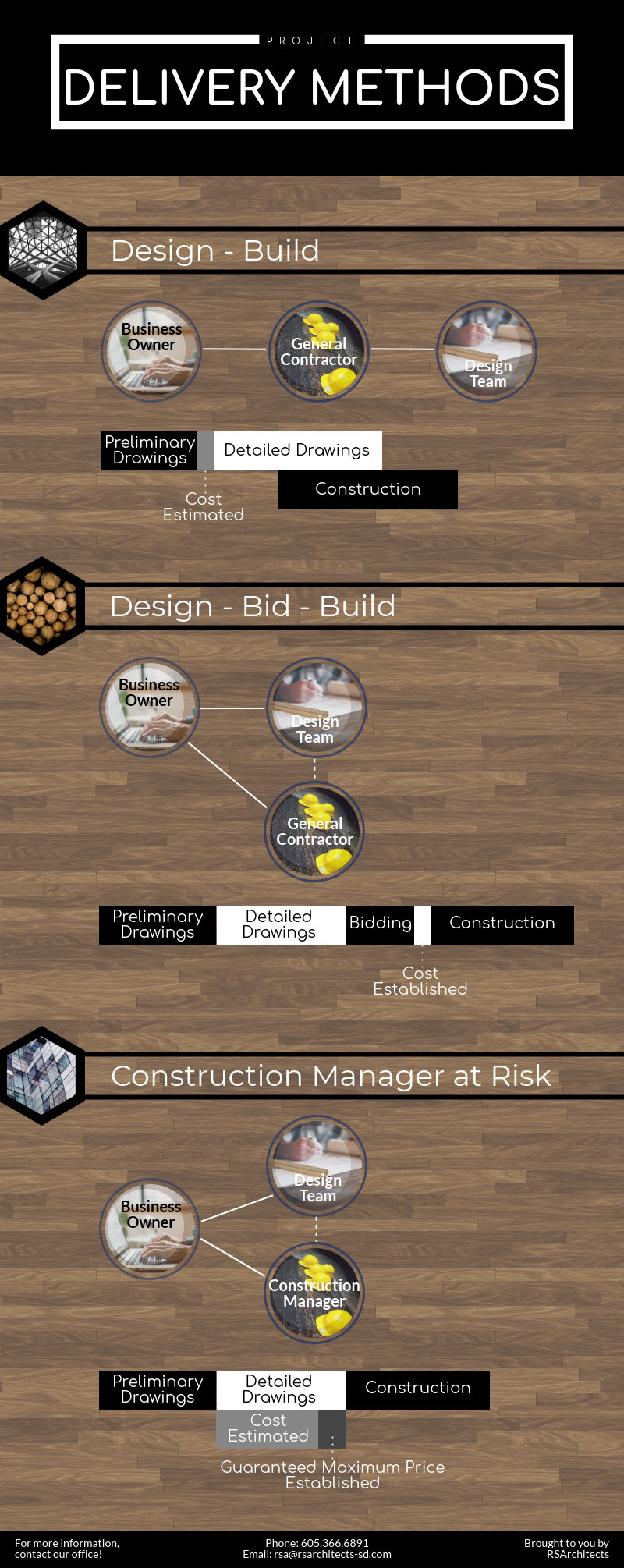
Design-Build, Design-Bid-Build, and CM-R...what's the difference?
January 3, 2019
When it comes time to expand your business into a space that is all your own, you’re bound to encounter unfamiliar terms. You know you need someone to design the space and someone to build the space, but now you--the project owner--must choose a method of delivery for these two services.
If you aren’t familiar with the delivery methods available, we’re here to help! The three most common methods are Design-Build, Design-Bid-Build, and Construction Manager at-Risk (CM-R for short). Keep reading for an overview of each method:
Design-Build is a relatively new delivery method, but has really taken off in the industry. With this method, the project owner only has to hire one company. This allows the project owner to get the design and build done under a single contract, with a stream-lined channel of communication.
Typically the primary contract is held between the owner and general contractor, who then is responsible for the design and build. The contractor will hold separate contracts with the design team and subcontractors, and will manage the project.
During a Design-Build, construction and design take place simultaneously. This means the design and construction overlap throughout the process. Once the general footprint of the building is designed, construction gets underway. The design for the building continues to develop, with each phase of construction right on the heels of the design.
Design-Bid-Build has been considered the traditional method of delivery, and is still a very popular choice. The first step in Design-Bid-Build is for the owner to contract with an architect. The architect works with the owner to realize the design, and produce complete design and construction documents.
The next step is the solicitation of bids from contractors. This can be done as either an open bid or by invitation only. Contractors use the construction documents to determine the building costs for the project, and offer a fixed fee to do the work.
Often, but not always, the project owner will select the low bidder. Sometimes, the architect is asked to assist in the selection of a contractor. The project owner then enters into a contract with the selected contractor and construction begins.
Now the project owner has a contract with both the architect and the contractor, however, the architect typically remains the main point of contact. The architect acts as an advocate on behalf of the project owner, working with the contractor to ensure the integrity of the design is upheld in the construction.
Construction Manager at Risk (CM-R) is a delivery method that combines parts of the Design-Build and Design-Bid-Build methods, with some of its own uniqueness. Similar to Design-Bid-Build, the project owner first selects and contracts with an architect. Together, they begin the design process.
Early in the design process, the project owner also contracts with a construction manager who is brought on board as an integral part of the design team. The construction manager (CM) provides a host of services during the design phase, which include assisting with value engineering, material comparisons, cost estimating, reviewing the design for constructability, and scheduling.
Similar to Design-Build, once the CM is brought on board there can be some overlap of design and construction taking place. This overlap usually includes only early steps of construction, such as excavation and site development, but nevertheless it accelerates the overall timeline compared to the traditional Design-Bid-Build.
When the design phase is nearing completion, the CM presents the project owner with a GMP, which stands for Guaranteed Maximum Price, and the CM must deliver the completed project for no more than that price. This is what puts the “at-Risk” into the CM-R title.
The CM is taking a risk by guaranteeing a set amount, because unforeseen circumstances could increase the project cost. In that case, the construction manager must absorb the loss.
Once the project is in the construction phase, the construction manager may perform work on the project, or rely solely on subcontractors, and is ultimately responsible for the completion of the build.
Choosing the best delivery method is a matter of deciding what is right for your specific project, and what is most important to you. Completing the project in a short timeline will mean one method, while ensuring an award-winning design will mean another.
RSArchitects has experience in all three of these delivery methods and we’d be happy to help you choose what is best for you and your project. If you’d like more information, email us at rsa@rsarchitects-sd.com, call us at 605.336.6891, or visit our office at 2307 West 57th Street in Sioux Falls, and we’ll help you get your project started!